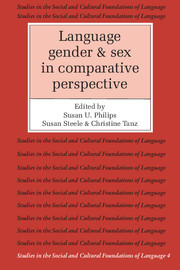Book contents
- Frontmatter
- Contents
- Acknowledgments
- List of contributors
- Introduction: The interaction of social and biological processes in women's and men's speech
- Part I Women's and men's speech in cross-cultural perspective
- Introduction
- 1 The womanly woman: manipulation of stereotypical and nonstereotypical features of Japanese female speech
- 2 The impact of stratification and socialization on men's and women's speech in Western Samoa
- 3 The interaction of variable syntax and discourse structure in women's and men's speech
- 4 A diversity of voices: men's and women's speech in ethnographic perspective
- 5 Women's speech in modern Mexicano
- Part II Gender differences in the language of children
- Part III Sex differences in language and the brain
- References
- Index
5 - Women's speech in modern Mexicano
Published online by Cambridge University Press: 05 June 2012
- Frontmatter
- Contents
- Acknowledgments
- List of contributors
- Introduction: The interaction of social and biological processes in women's and men's speech
- Part I Women's and men's speech in cross-cultural perspective
- Introduction
- 1 The womanly woman: manipulation of stereotypical and nonstereotypical features of Japanese female speech
- 2 The impact of stratification and socialization on men's and women's speech in Western Samoa
- 3 The interaction of variable syntax and discourse structure in women's and men's speech
- 4 A diversity of voices: men's and women's speech in ethnographic perspective
- 5 Women's speech in modern Mexicano
- Part II Gender differences in the language of children
- Part III Sex differences in language and the brain
- References
- Index
Summary
In studies of the role of women in language change conducted among speakers of world languages in urban centers, a paradoxical pattern has been identified (Labov 1978). Women are more conservative than men in cases of stable variation but are more innovative in cases of change in progress, particularly if the change is an assimilation toward an elite norm. Women seem to be more sensitive to such norms than men, and to be more sensitive to the stigmatization of vernacular usage. Women speakers of Mexicano (Nahuatl), an indigenous language of Mexico, who live in rural communities in the region of the Malinche Volcano in the central Mexican states of Puebla and Tlaxcala, display a similarly paradoxical pattern of simultaneous linguistic conservatism and sensitivity to stigmatization. Like most male members of their communities, most of these women are bilingual in Spanish. The most significant variability within the kinds of usage these speakers define as “speaking mexicano” results from symbolic work in which they manipulate elements they consider to be castellano ‘Spanish’ in order to produce different speech registers. Women exhibit a different pattern of such manipulations from men. People in the communities hold that women are always “less Spanish” than men, and for some aspects of usage this is so. But for some usages where self-conscious purism in speaking mexicano has stimulated male avoidance of castellano elements, women are “more Spanish” (or “less Mexicano”) than men.
- Type
- Chapter
- Information
- Language, Gender, and Sex in Comparative Perspective , pp. 121 - 160Publisher: Cambridge University PressPrint publication year: 1987
- 39
- Cited by



